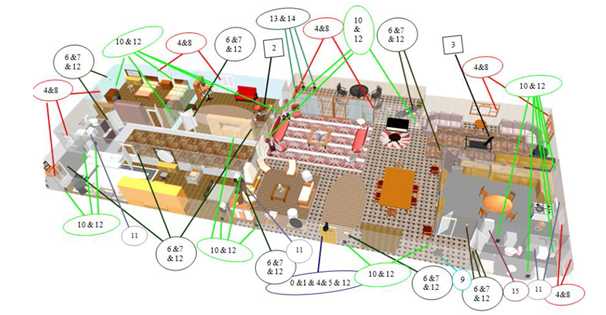MOJ
eISSN: 2572-8520


Review Article Volume 2 Issue 1
1Department of Mechanical/Mechatronics, NMIMS University, India
2Department of Mechatronics, NMIMS University, India
Correspondence: Girish Santosh Bagale, Department of Mechanical/Mechatronics, NMIMS University, India
Received: October 22, 2016 | Published: January 23, 2017
Citation: Bagale GS, Shah N. Smart technologies/systems in home automation: a review and guideline to implement for smart real estate projects. MOJ Civil Eng. 2017;2(1):7-10. DOI: 10.15406/mojce.2017.02.00021
In this era, the smart home is not a new name, Smart home technology started for more than a decade to introduce the advanced technological systems that allow the automation of domestic tasks are developing rapidly. New technologies and applications which enable communication between the household applications and users, thereby improving the monitoring and control capabilities can now be installed in Smart Homes today. This review article takes a look at the concept of Smart Homes and emerging technologies that can be installed in these Smart Homes.
Keywords: smart homes, smart grid, automation, technologies
Smart home implies an extension of the existing building automation systems but limited to individual homes. This involves control and automation of lighting, smart thermostats, air conditioning and even security systems. Smart home is not an isolated case but also depends on:
Smart Home defines a residence which uses a controller to integrate home appliances. These appliances are connected to Windows based PC or iOS system through a wireless networking system. These appliances are programmed to work on stand-alone basis. The home network includes but is not limited to communications, entertainment, comfort, security, and information systems.
There are various technologies for home automation such as
Introduction
IWT is used for internal and external short-range communication throughout smart home technology within a private home. They are more preferred to wired technologies. It gives benefits of lower cost of equipment and installation, faster deployment, extensive access and improved flexibility. It is implemented with the help of Graphic-User Interface (GUI) which enables easier monitor and control of appliances. There are various existing wireless communication technologies and network protocols which are discussed in 1.2 and compared in 1.3.
The Figure 1 given below shows a basic smart home. The contents are defined in the table following the figure. Types of IWT

Figure 1 Smart Home.7
In this paper, Smart homes and the existing technologies have been reviewed. Figure 1 shows a basic smart home and the following Table 1 shows the basic components of a smart home. Table 2 shows the existing technologies and network protocols in the Integrated Wireless Technology. The work done in this paper is expected to take efforts towards a user friendly system for smart home. These systems offer benefits to elderly and disabled human by making the accessibility easier. The following is the guideline to help implement:
Component |
Representative Number |
Palm Vein and Fingerprint Stamp Reader |
0 |
Electronic Knob and Bolt |
1 |
Central Control Unit |
2 |
Mobile remote Control Unit |
3 |
A moti on Sensor |
4 |
Front door alarm buzzer |
5 |
Home part alarm buzzer |
6 |
Electronic light switch |
7 |
Electronic door/Window opener |
8 |
Current Sensor |
9 |
Electronic switchers at an electrical outlet |
10 |
Smoke detector and gas detector |
11 |
3-axis accel erometer |
12 |
Temperature, humidity, and soil moisture sensors |
13 |
LCD display |
14 |
Light intensity sensor |
15 |
Table 1 Components of Smart Home figure7
IWT |
Max Transmission Speed/Operation Range |
Transmission Distance |
Standard |
Internet Protocol (IP) Support |
Adoption Rate |
Strength |
6LoWPAN |
250 kbps, 2.4 GHz; |
Up to 200m. |
IETF RFC 4944; |
IPv6 |
Medium |
(1) Benefits of both IP and Bluetooth; |
Bluetooth |
721 kbps for v1; 2.1 Mbps for v2.0 +EDR **; |
10 m typical |
IEEE 802.15.1 |
- |
Extremely high |
(1) Ease of access; |
DASH7 |
200 kbps |
0–500 m and |
ISO/IEC |
Yes |
Medium |
(1) It penetrates concrete |
En Ocean |
It is on the 868.3 or315 MHz frequency |
30 m (in-doors) |
ISO/IEC |
Yes |
Medium |
(1) Energy management and highly efficient energy storage; |
GSM |
270 kbps |
Several kilometres |
Gaussian |
Yes, static and dynamic IP. |
Widely adopted |
(1) Low cost; |
MyriaNed |
2.4 GHz radiofrequency;868 MHz radio frequency; Other frequencies are under development |
Several Meters |
MyriaNed |
Yes |
Medium/low; the system is developing |
(1) Low energy usage; |
RFID |
Low 124-135 KHz; |
Low 30 cm; |
Various standards |
Yes |
Widely adopted |
(1) Stable technology; |
Table 2 Comparison between various IWT technologies6
None.
The author declares no conflict of interest.

©2017 Bagale, et al. This is an open access article distributed under the terms of the, which permits unrestricted use, distribution, and build upon your work non-commercially.